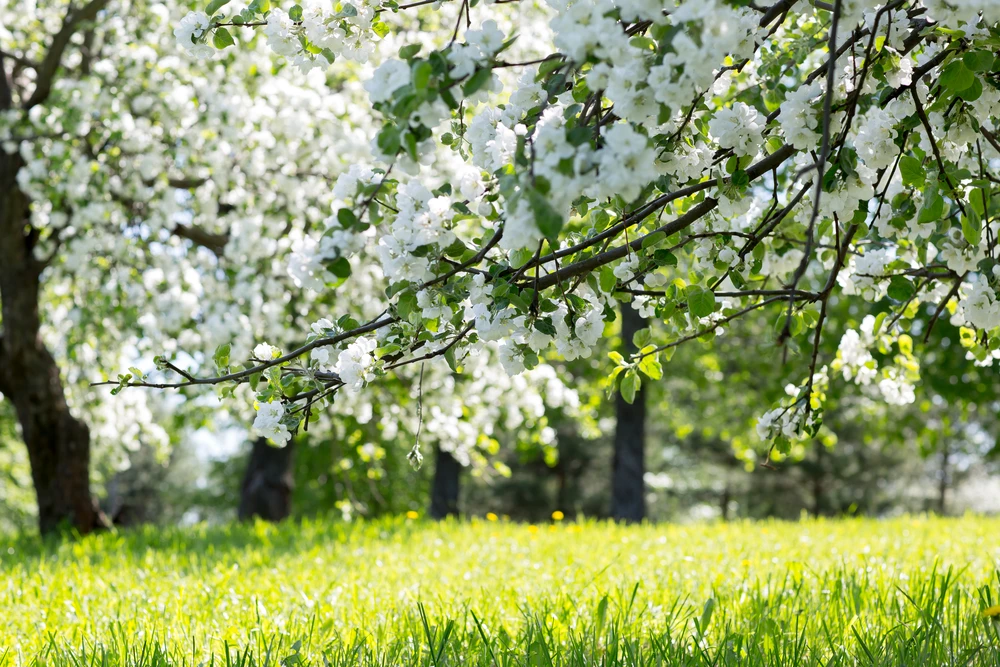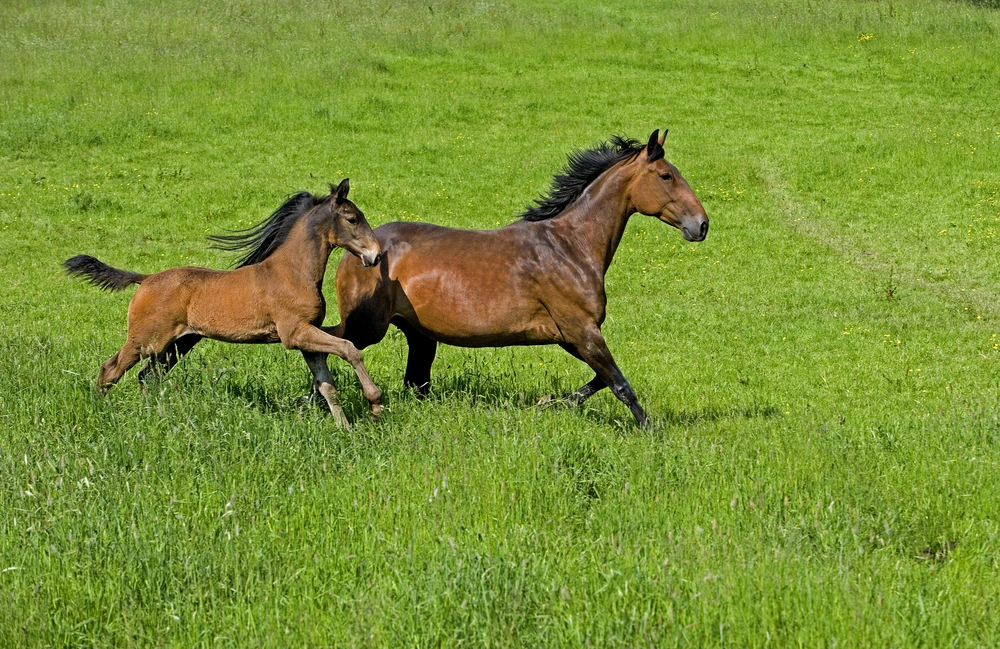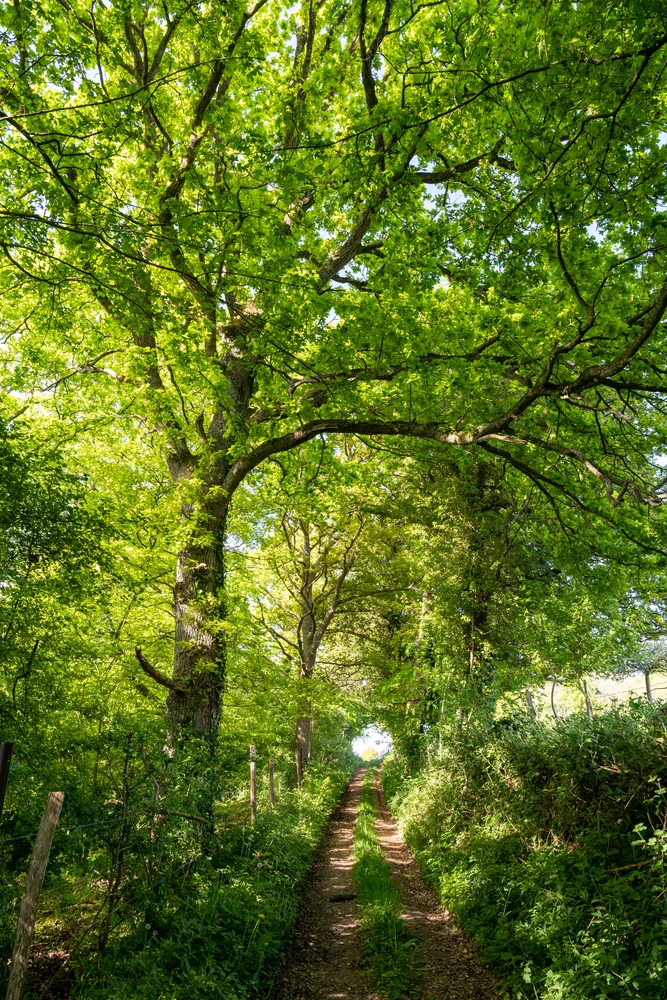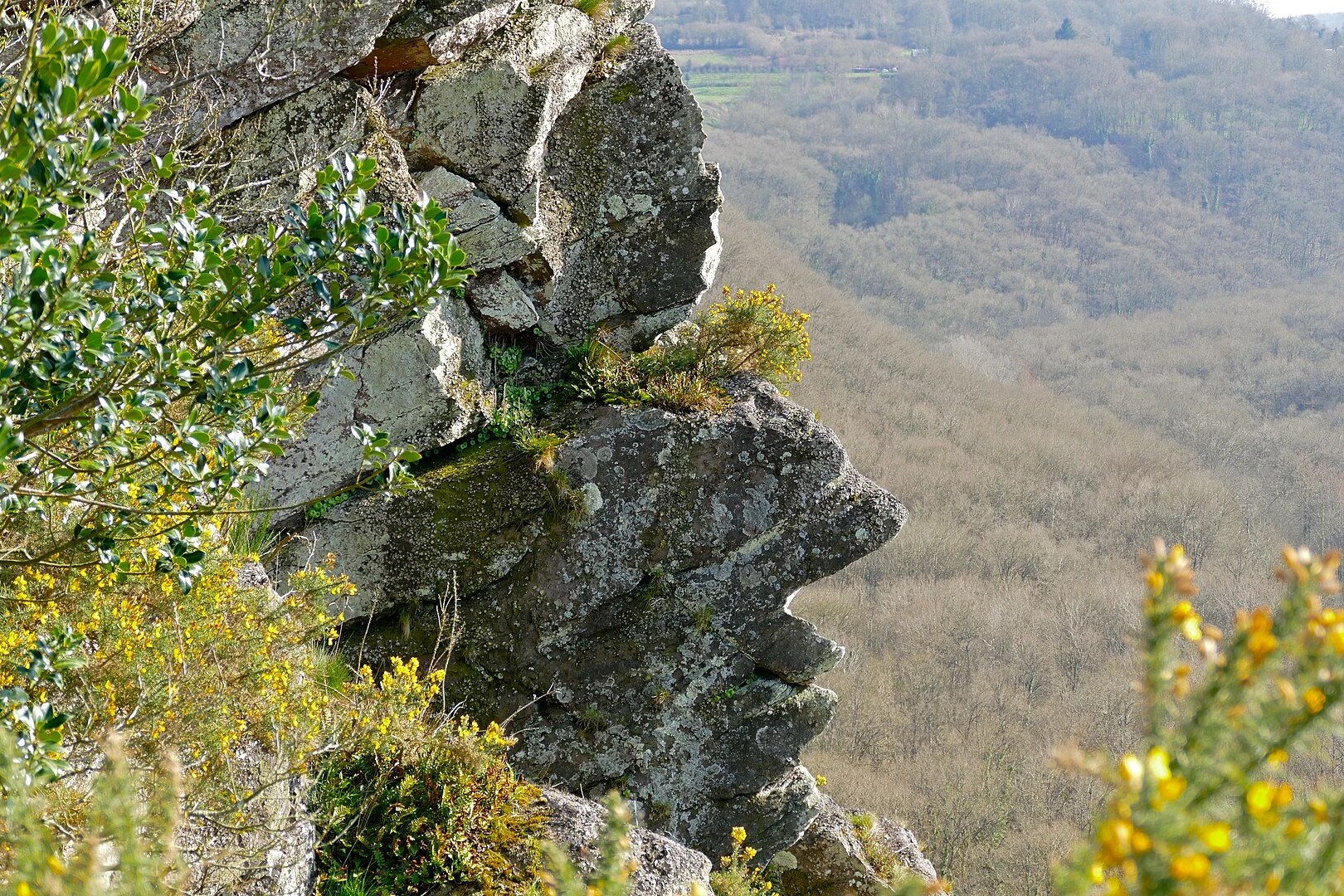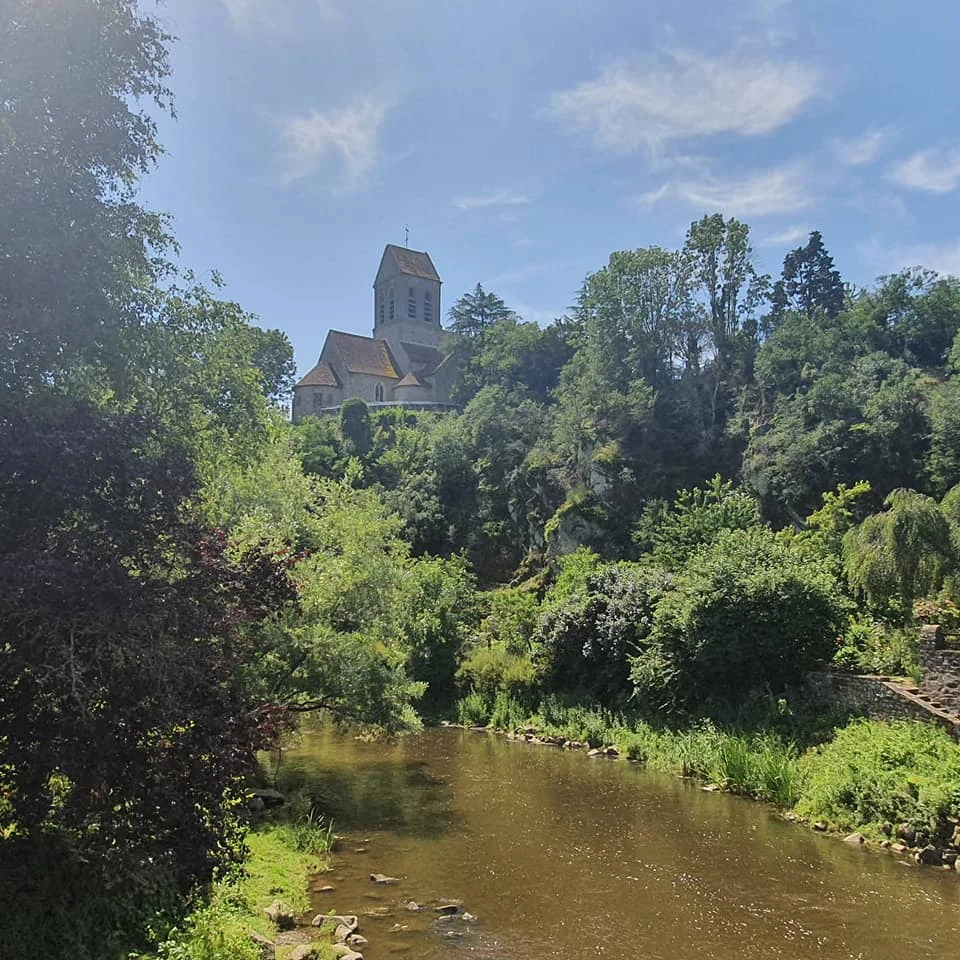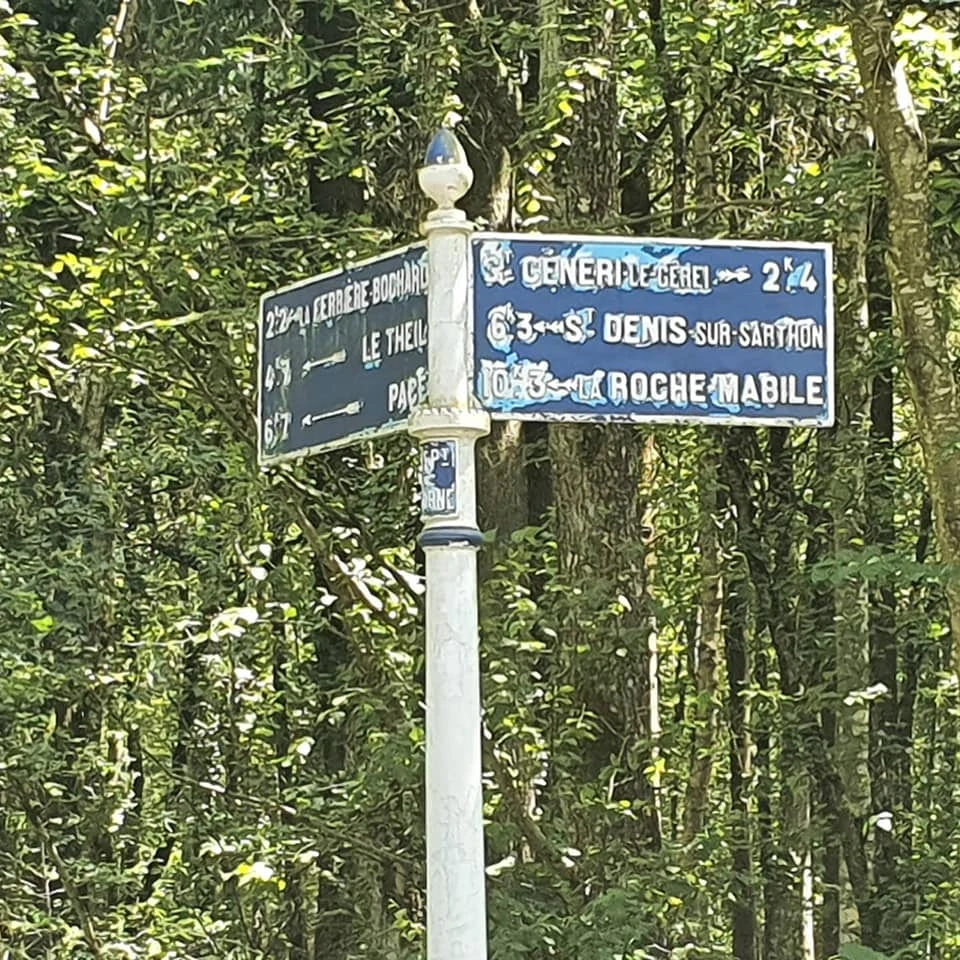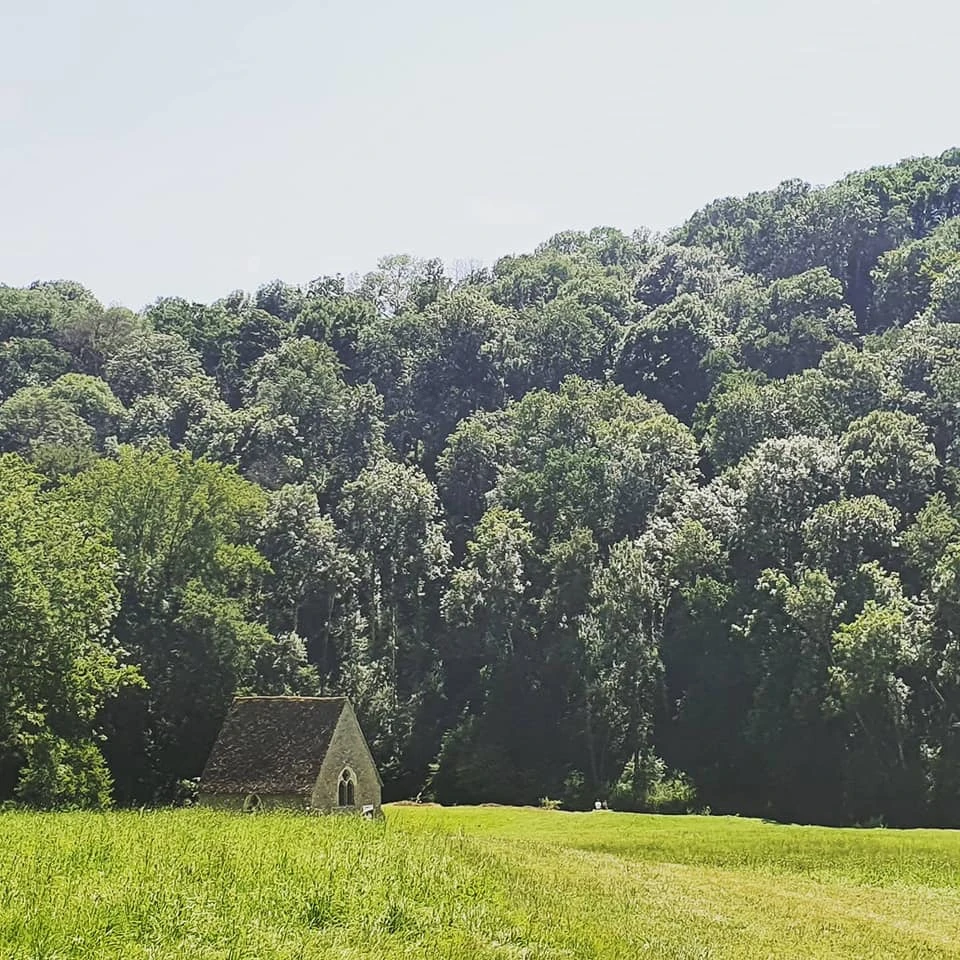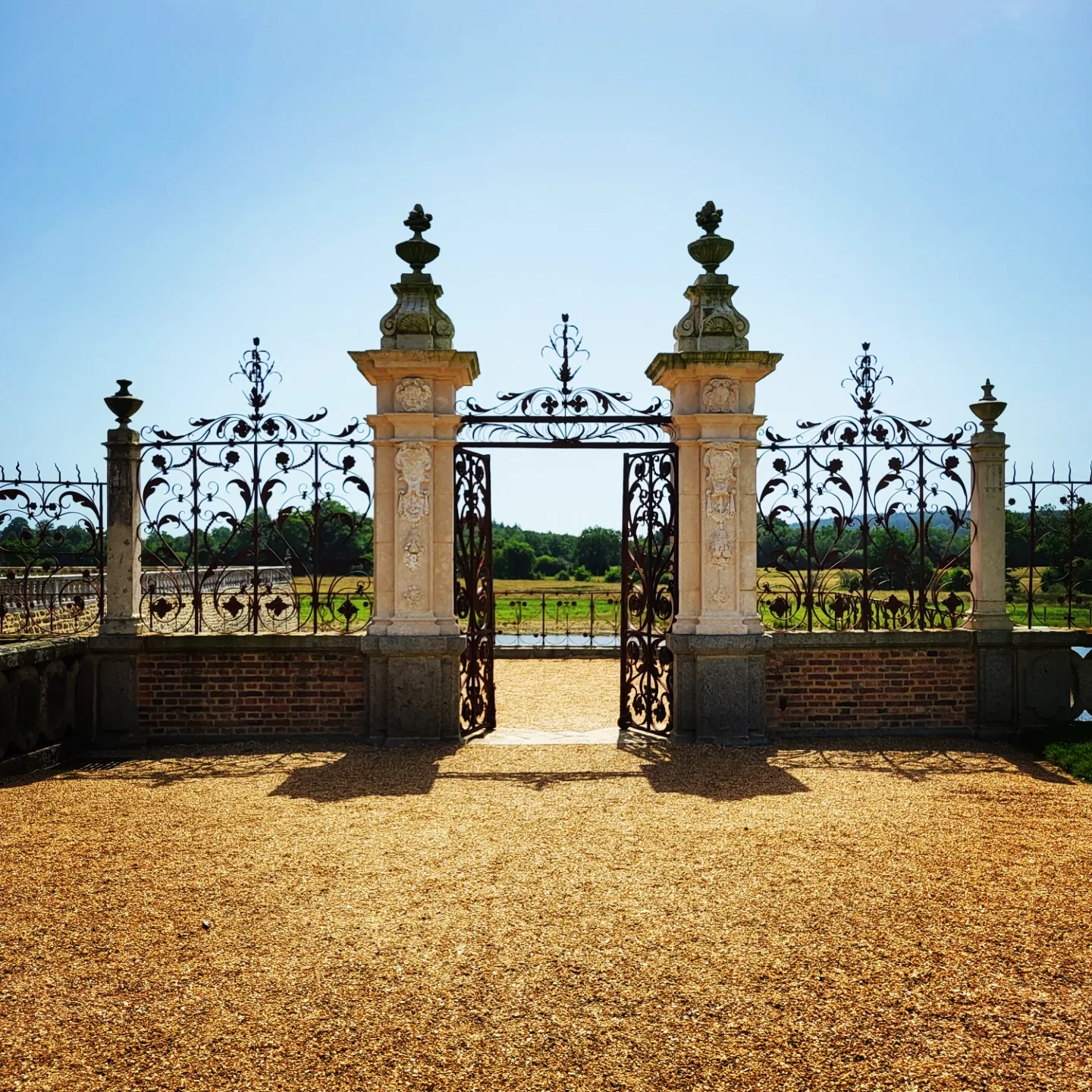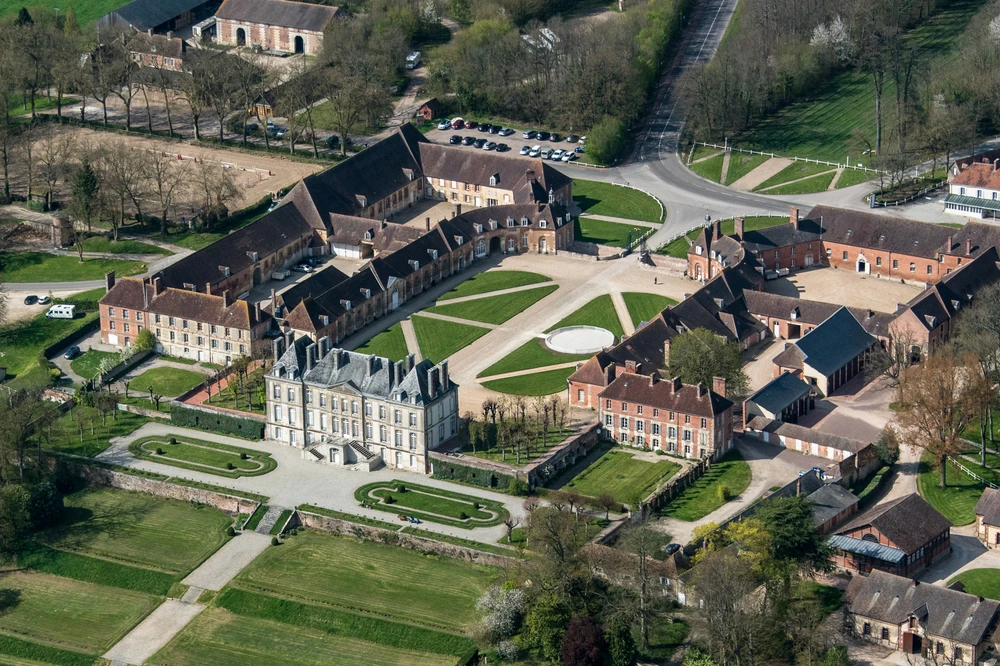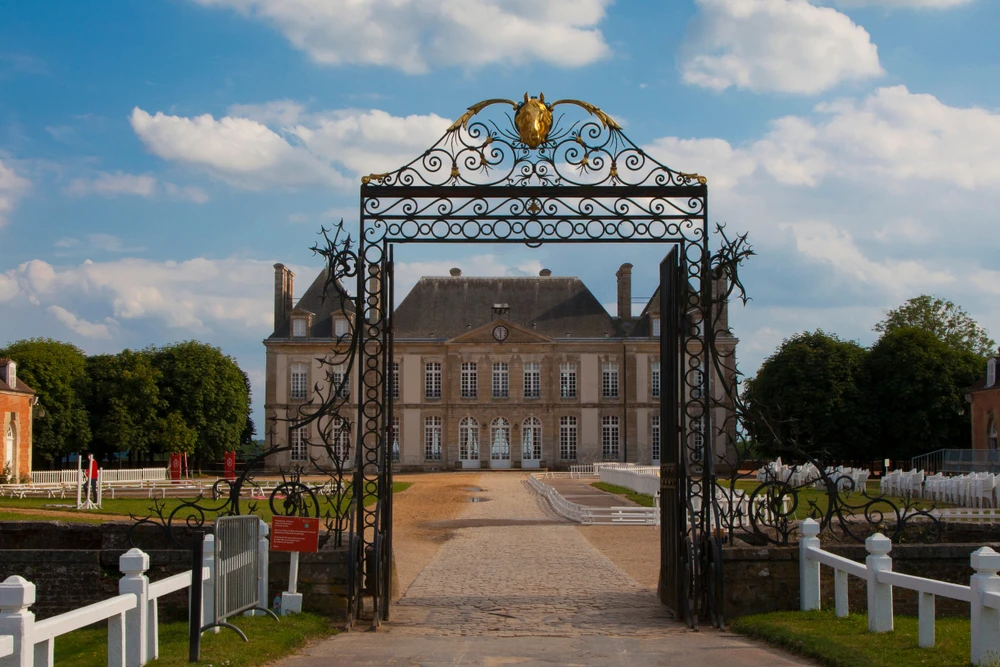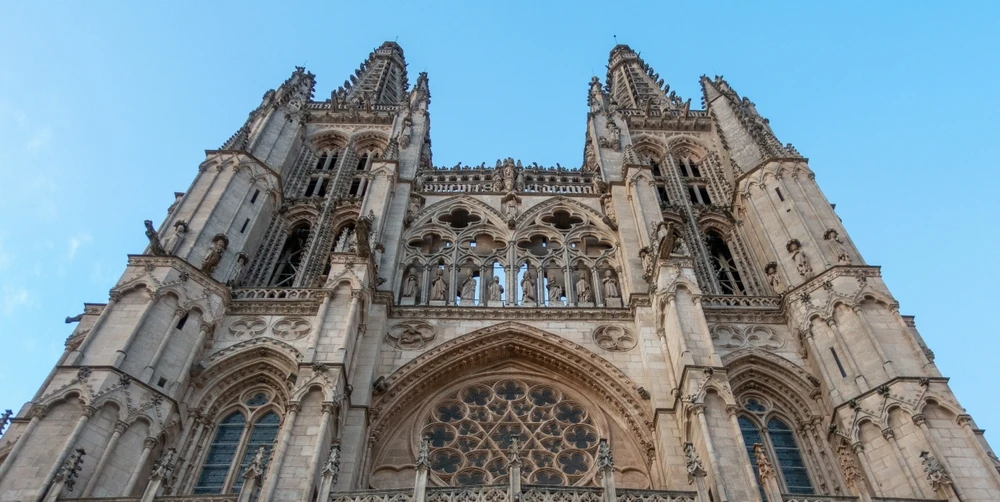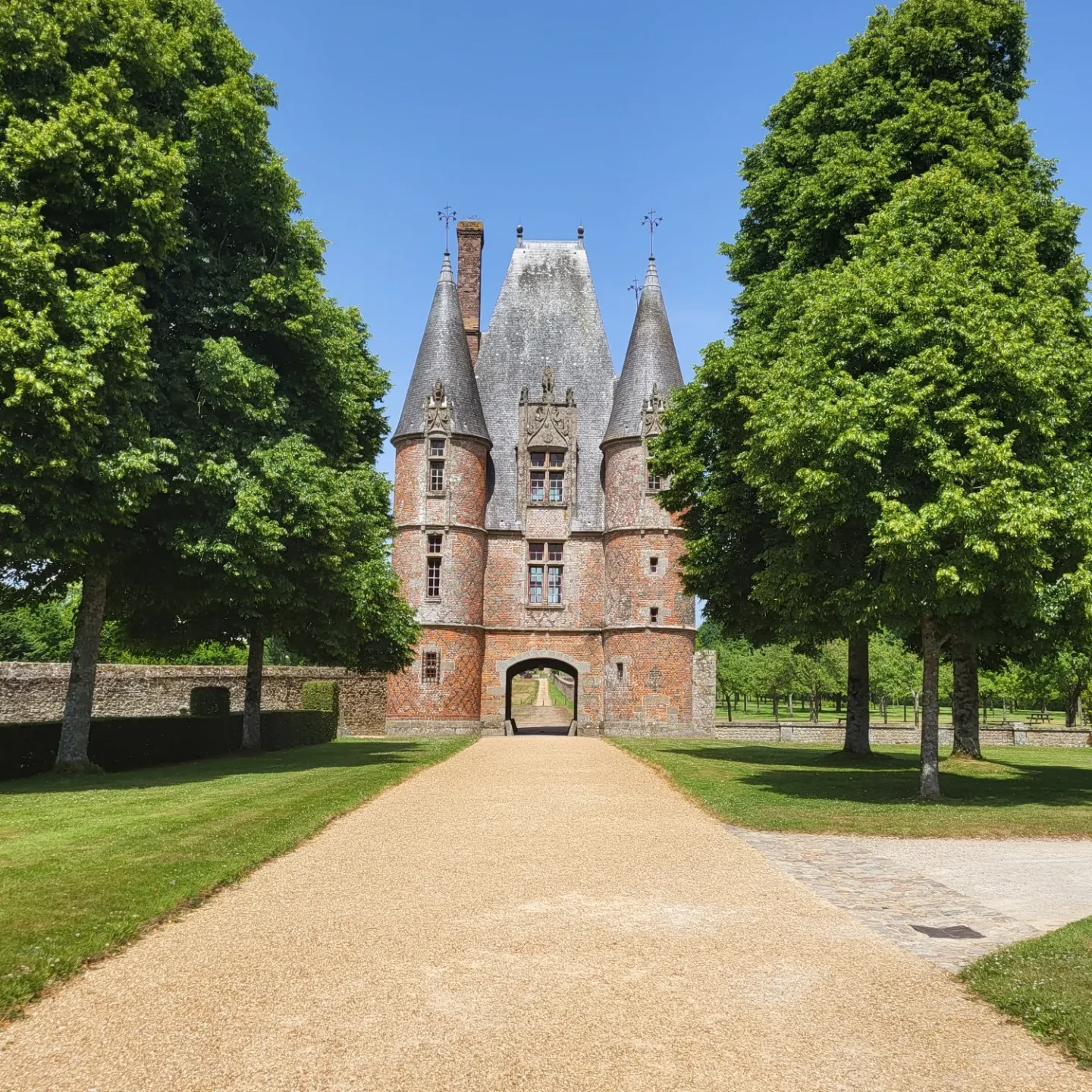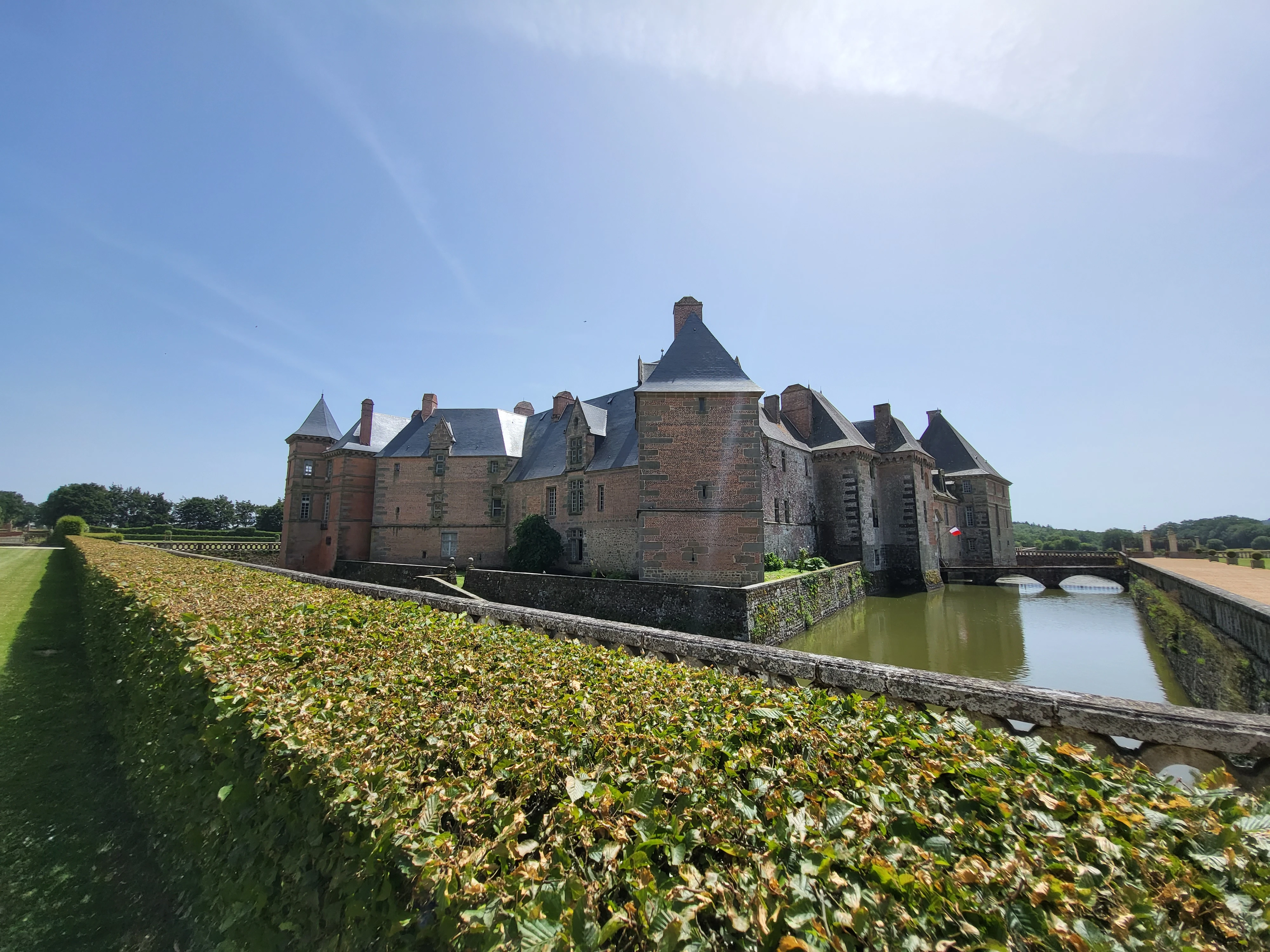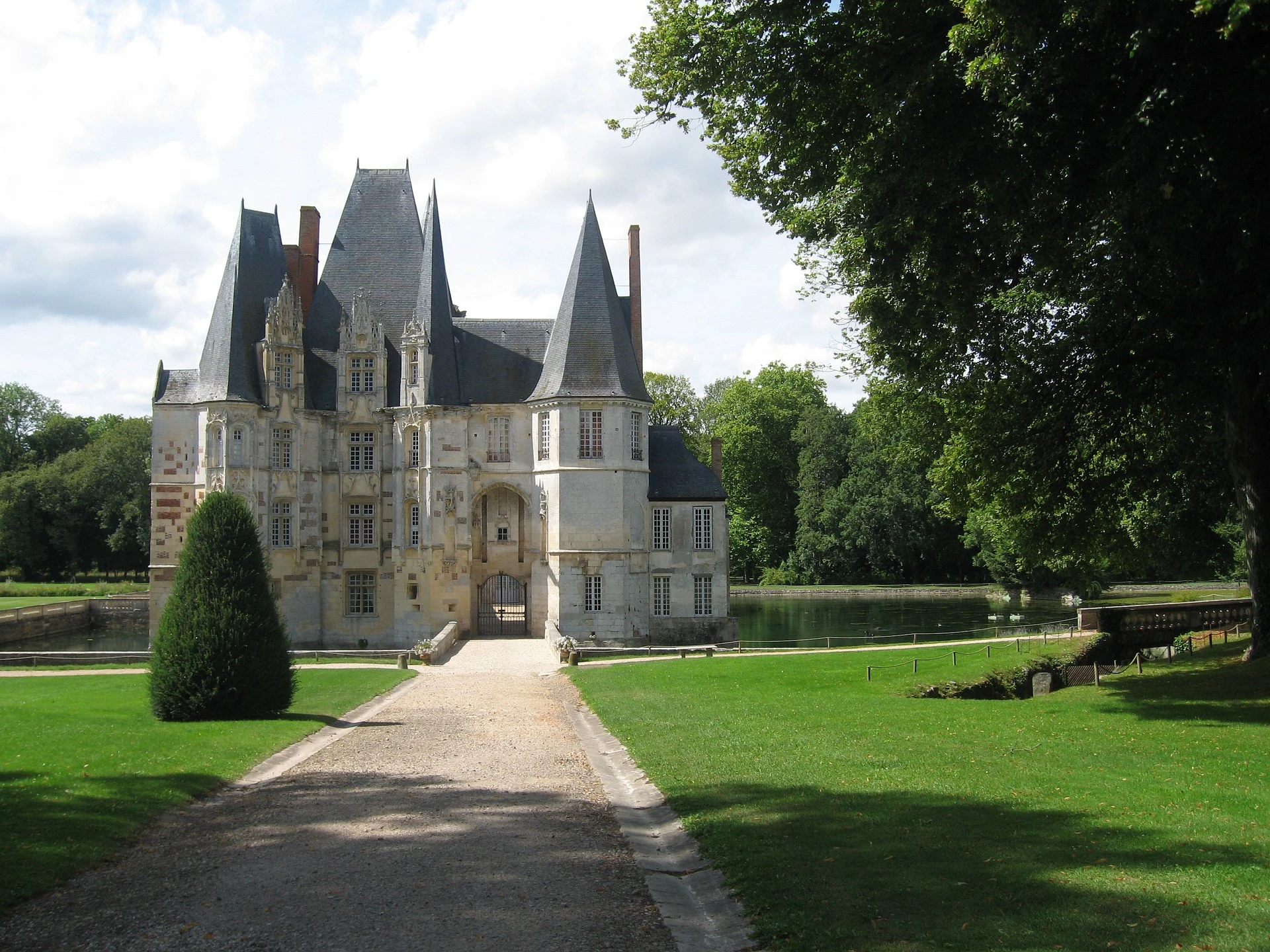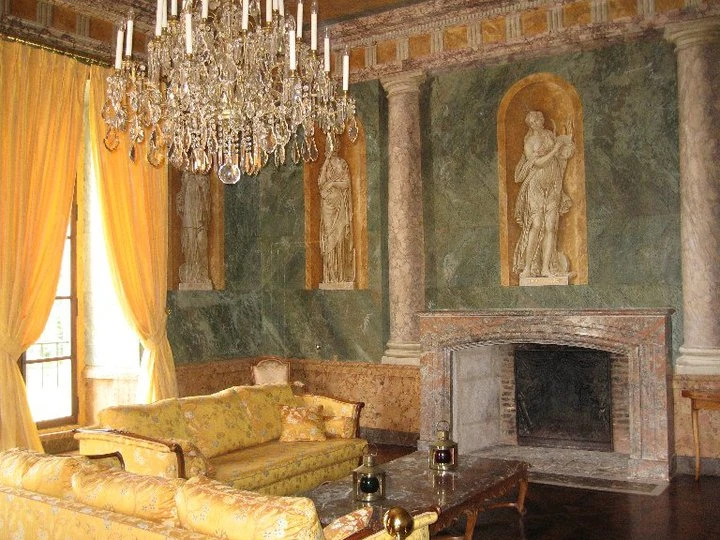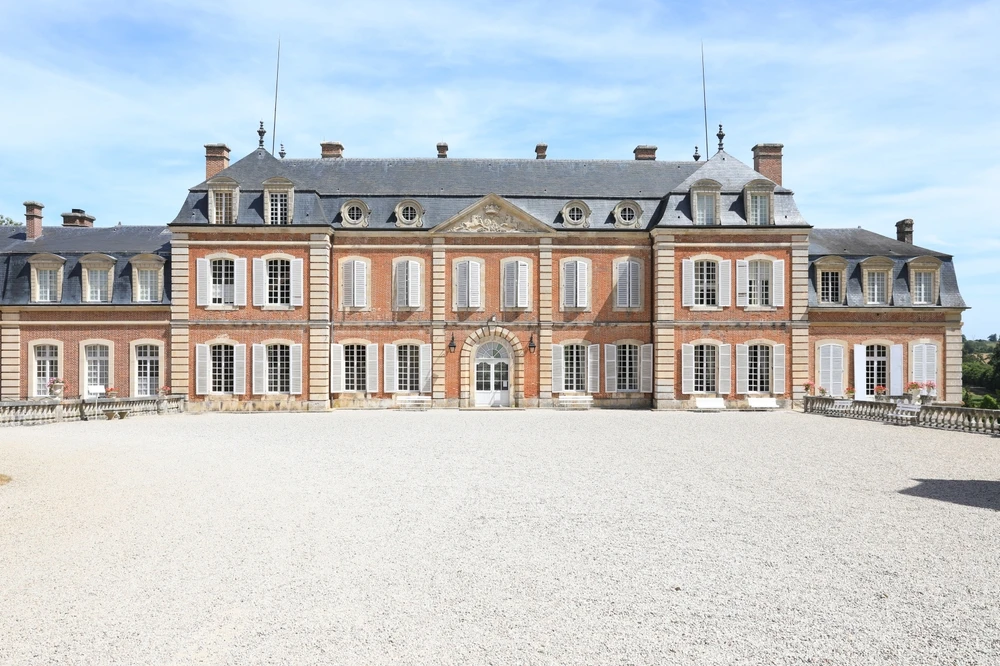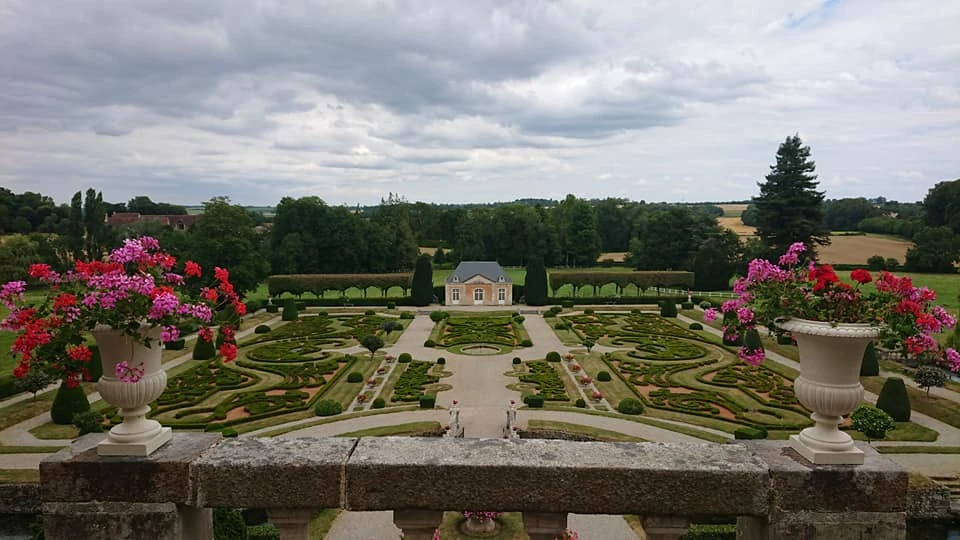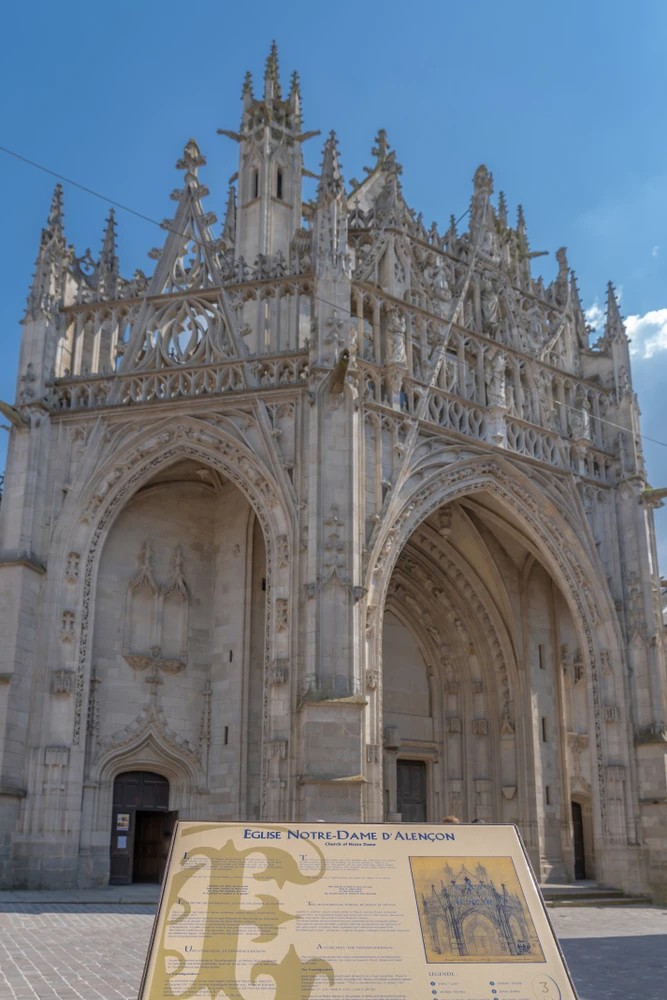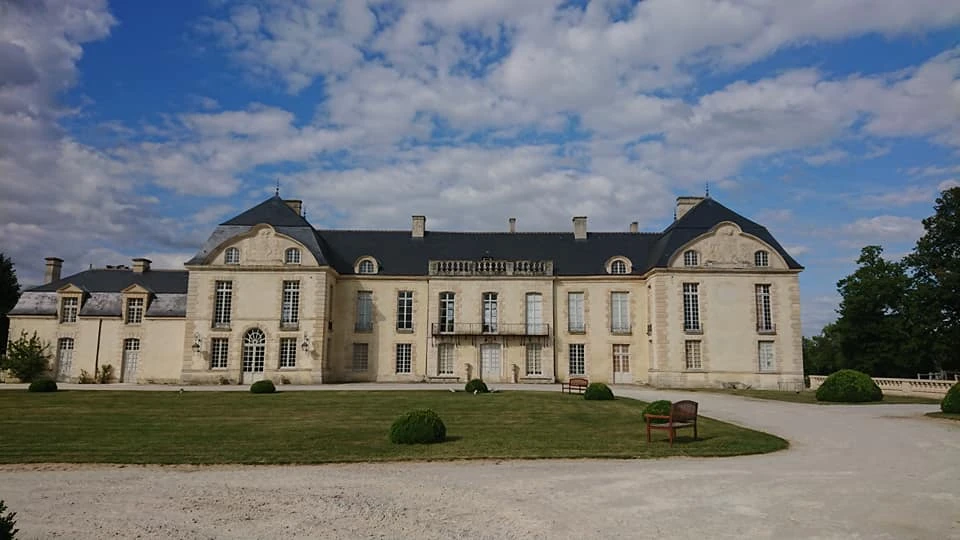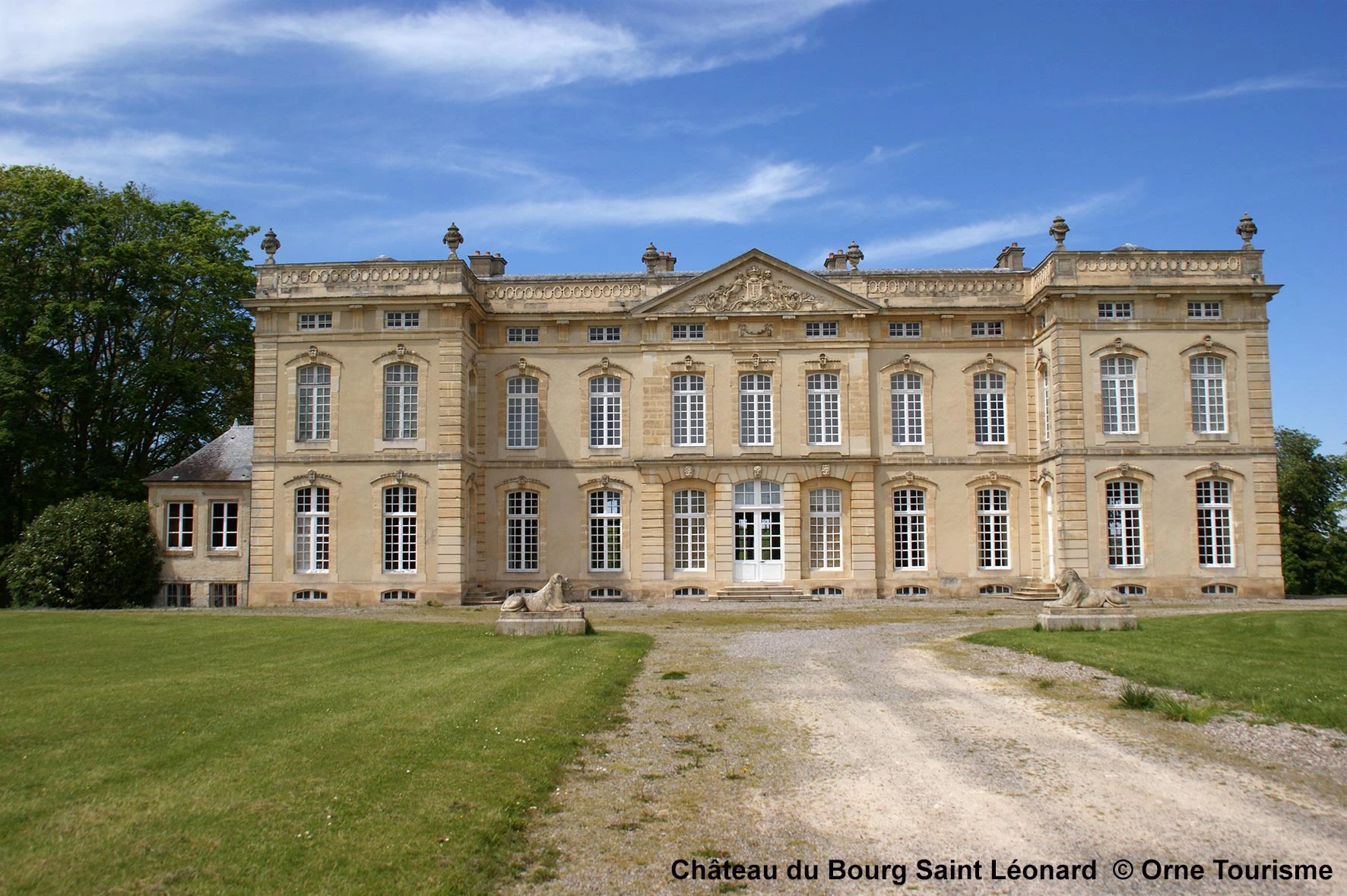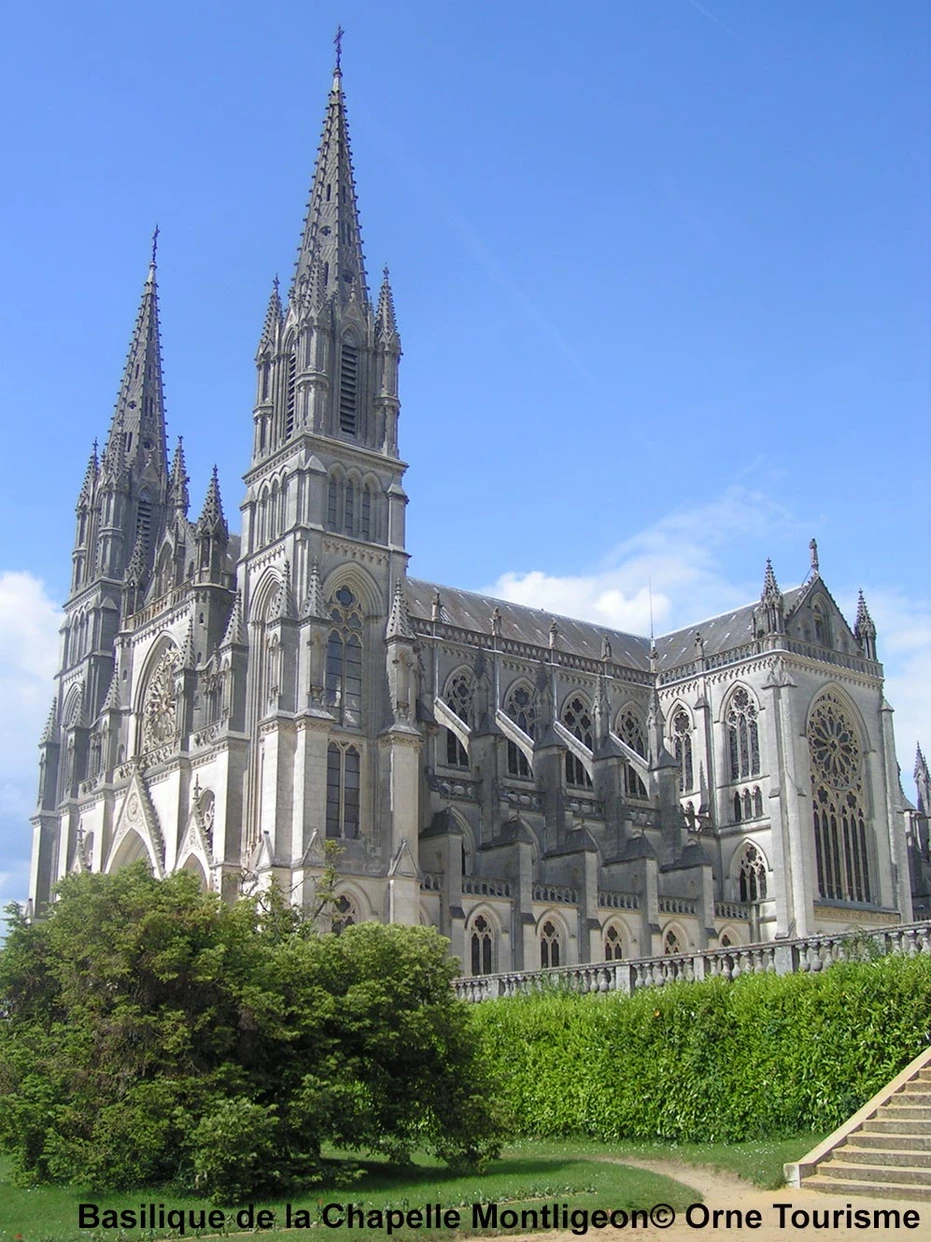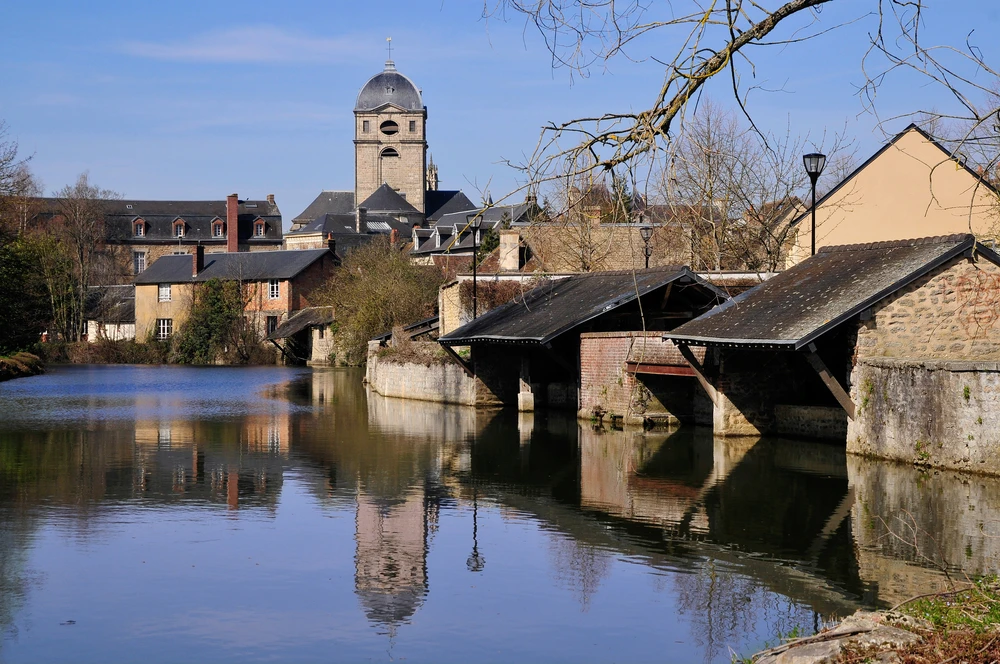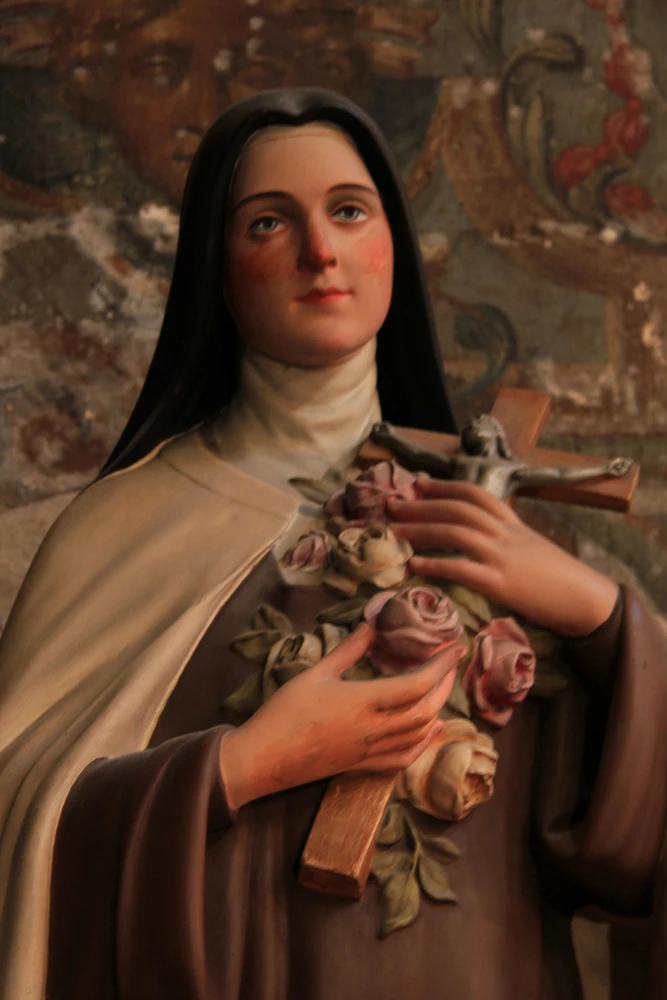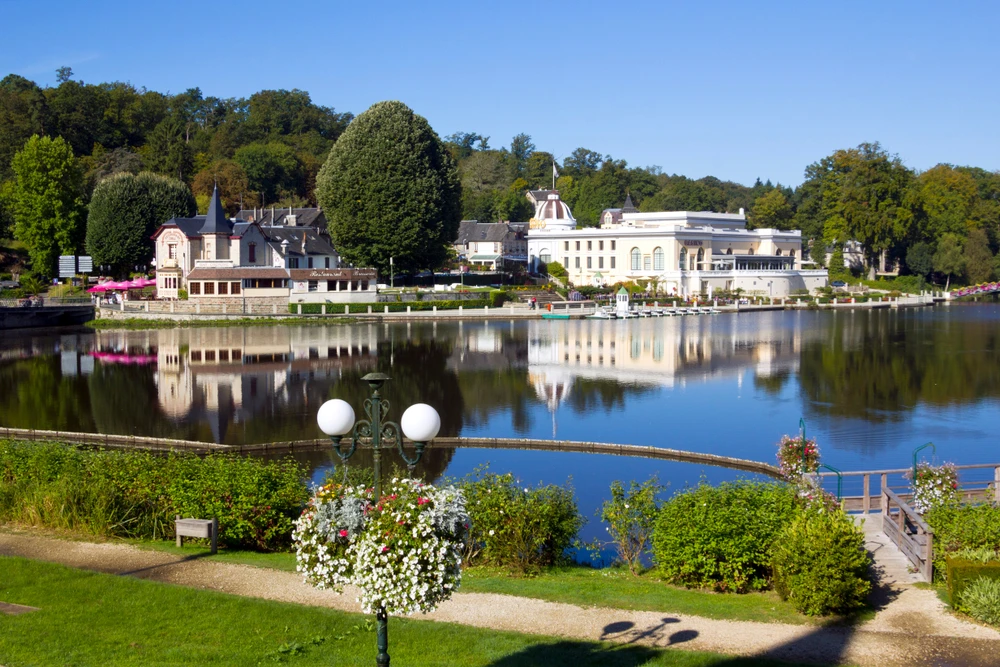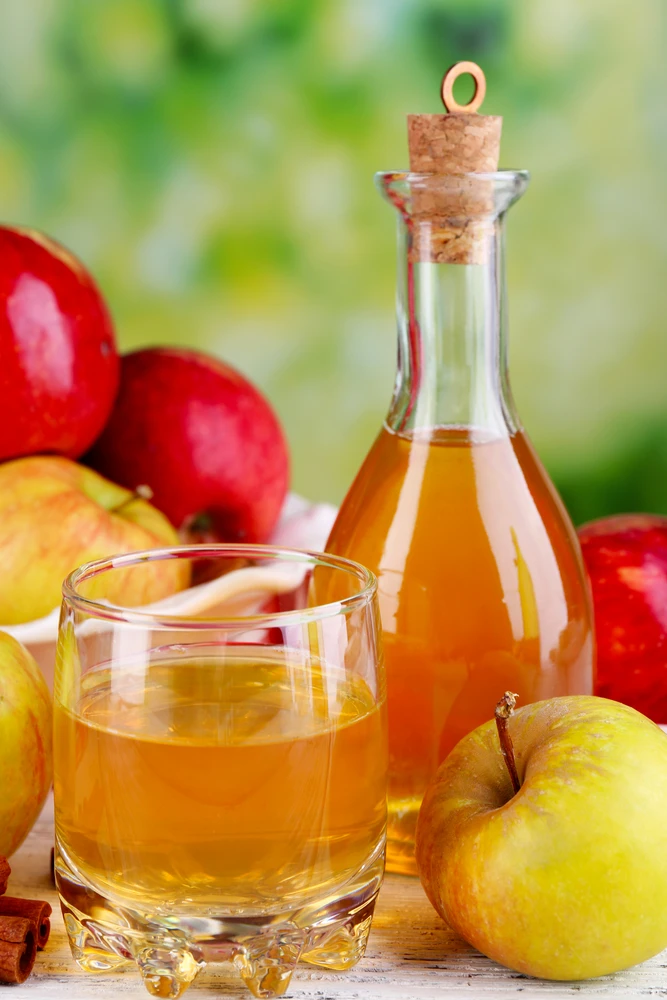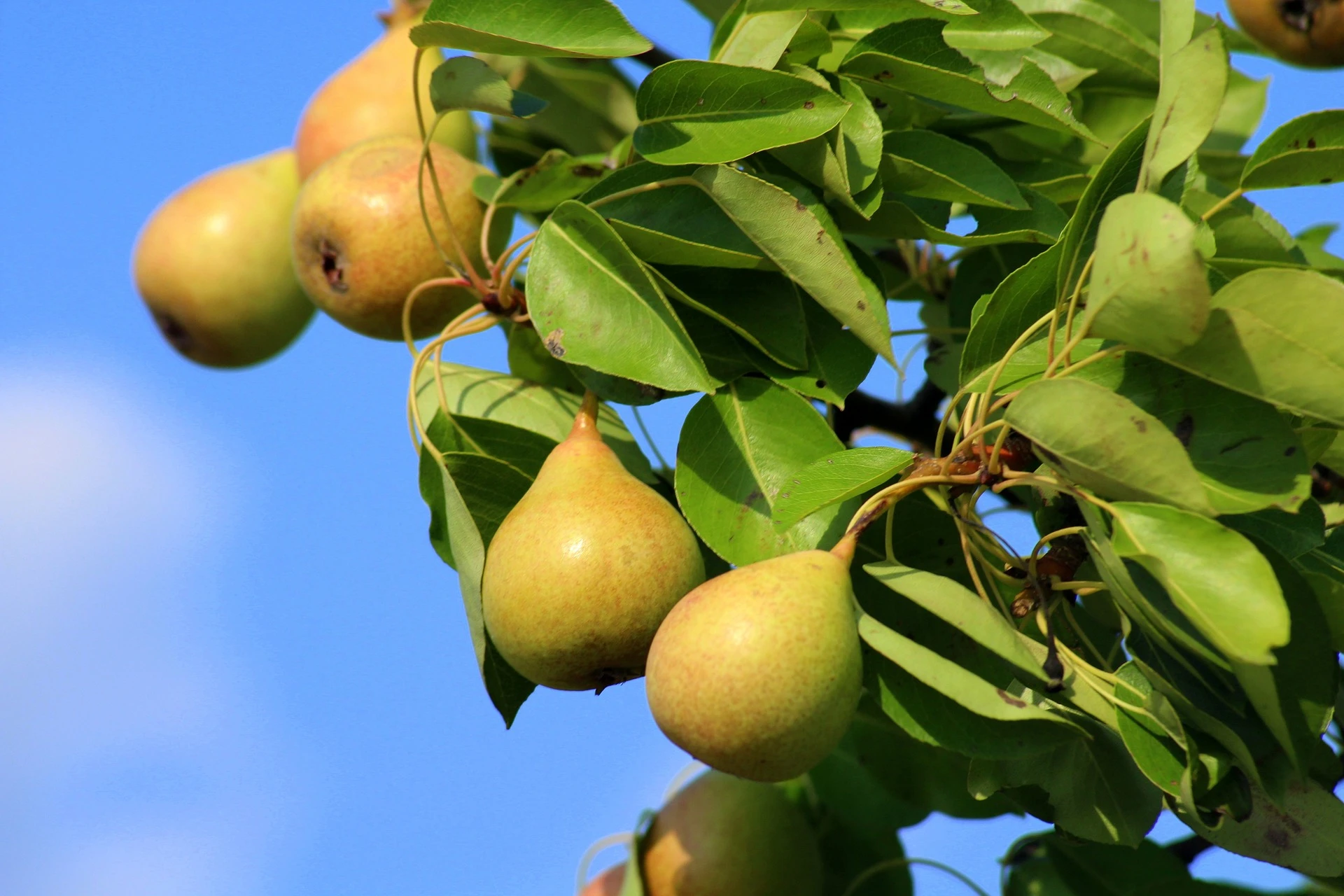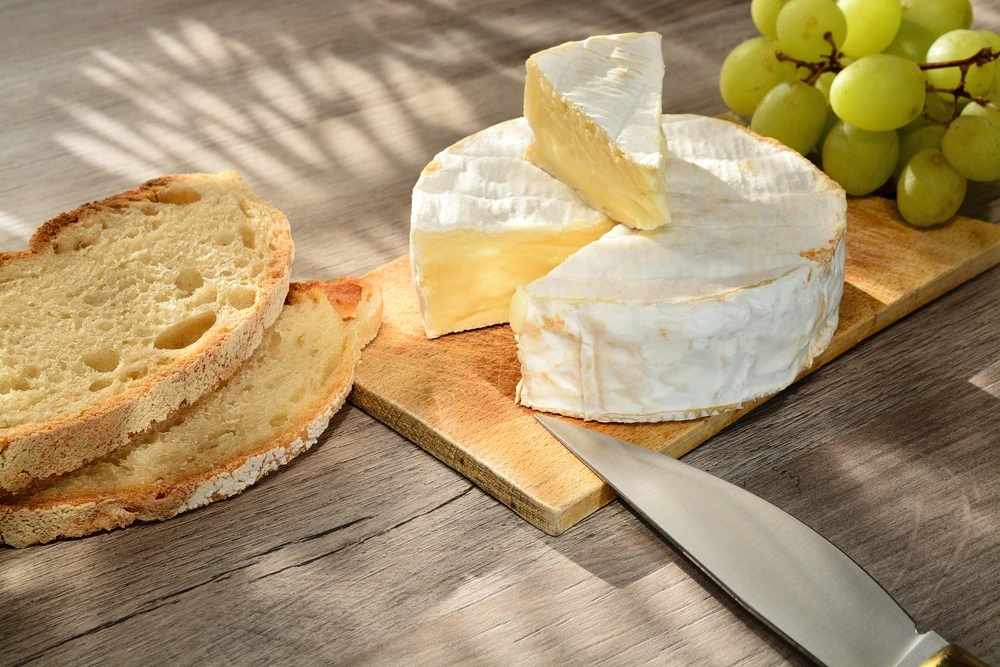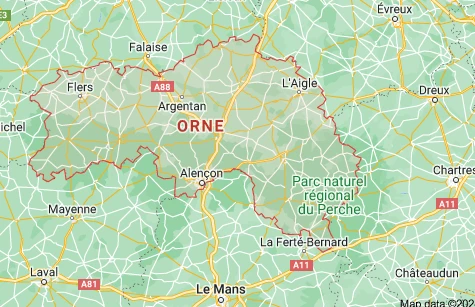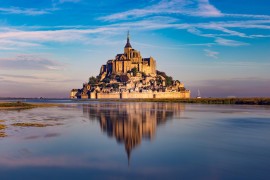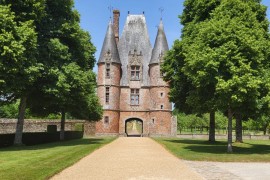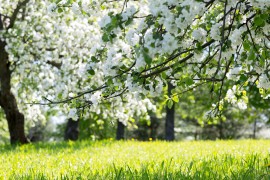There may be a few translation errors. Our translator went to visit two or three caves to taste Norman calva 2 days ago. He still hasn't returned...
Landscapes of the Orne
Apple trees in bloom somewhere in Normandy. Photo chosen by monsieurdefrance.com via depositphotos
The magical beauty of Normandy hedges
The Orne is a great place to discover the infinite variety of green. It's deep in summer, when the hedges are leafy, and an almost electric green when the Normandy spring arrives. Hedgerows have been neglected for many years, but there seems to be a growing awareness of their importance, and they are being removed less and less. These hedges line many small country roads that you'll want to take to get off the beaten track and discover a village around a bend, or a bucolic landscape in a green gap between two fields. From Montormel and its memorial, you can admire the immense checkerboard pattern of the Normandy bocage, with its famous hedgerows. If you love the countryside, the real thing, the one that's alive and kicking and not yet a museum, it's in a small Orne rural gîte that you'll spend a nice weekend or a few days to relax and enjoy the passing of time, listening to the sounds of the countryside: from bells and tractors to morning bees and evening crickets.
The beauty of Normandy hedges. Photo chosen by Monsieurdefrance.com: peresanz via depositphotos.
The Orne countryside is also home to the famous apple trees (or pear trees in the Domfrontais region) that have become the emblematic postcard of Normandy. The apple trees are in bloom in April or May, depending on the season. The apples are harvested in October, when the landscape turns red, brown and deep green after a few days of an Indian summer that has little to envy of the Canadian Indian summer. Canada is very much a part of Normandy, as many Quebec settlers have their roots here, often in the Perche region. In the 16th and 17th centuries, many Normans from Orléans left their native village to cross the ocean and establish a new life far away. Many Canadians took part in the Battle of Normandy in 1944, when freedom had to be won back for the land of their ancestors.
Normandy cows. Photo chosen by Monsieurdefrance.Com hzparisien@gmail.com via dépositphotos.
It's also in the fields of Orne that you'll come across the famous Normandy cows , with their chestnut-stained white coats and long eyelashes, which produce fatty milk ideal for making the cream that Normans love, butter and the famous Camembert that was born here, in the Orne region, in the little village of Camembert , where you can visit the Maison du Camembert, and where the famous Marie Harel has not been forgotten. She invented this cheese by chance, modifying a recipe for Brie given to her by a priest from the Brie region. A delicious cheese that seduced Emperor Napoleon III, who was visiting Argentan, not far from here, before conquering France and even witnessing its defense by the "Poilus", since it was part of the bag of French soldiers in the First World War.
A mare and her foal somewhere in Normandy / Photo chosen by monsieurdefrance.com: slowmotiongli via depositphotos.
Finally, the Orne is horse country. France's leading department for breeding trotters, for example. The equine breed has its own Versailles in Orne, with the magnificent Haras du Pin, between Argentan and Mortagne au Perche. This superb red-and-white site was founded in the 17th century on the orders of Colbert, Louis XIV's minister, to develop these horses so useful for trade and war.
Explore the forests of Ecouves and Andaine
Forests are important in Orne, covering 17% of the département. With the added bonus of hedgerows, trees are king. In total, between forest (85,000 hectares) and hedgerows (15,000 hectares), trees alone cover more than 100,000 hectares, i.e. 10 times the surface area of Paris. There are numerous hiking trails in the Ecouves forest (between Carrouges and Alençon), which covers 15,000 hectares and 18 communes around the Signal d'Ecouves, at 413 metres, barely 4 metres lower than Mont des Avaloirs in the neighbouring department of Mayenne, the highest point in Western France. The same applies to the Andaine forest (around Bagnoles de l'Orne), which covers almost 5,000 hectares. To find out more about these trails, simply contact the tourist offices. You'll find ideas and routes for walking, cycling or even horse-riding here . Finally, in the Perche region, the Forêt de Bellême is magnificent.
Normandy forest. Photo chosen by monsieurdefrance.com: Leitenberger via depositphotos.
HOW TO GET THERE
La forêt d'Ecouves: address to start with Carrouges 61320 (where you can also visit the castle).
Distance from Paris: 209 kms. Distance from Caen 80 kms. Distance from Alençon 27 kms. Distance from Argentan 40 kms. Distance from Mortagne au Perche 64 kms.
La forêt d'Andaines: address to start with Bagnoles de l'Orne 61140 (take a tour of the lake first).
Distance from Paris: 237 kms. Distance from Caen 81 kms. Distance from Alençon 47 kms. Distance from Argentan 38 kms. Distance from Mortagne au Perche 82 kms.
Suisse Normande or the Alpes Mancelles
La Roche d'Oêtre, whose shape is reminiscent of a human profile. Photo chosen by monsieurdefrance.com: By Bernard DUPONT from FRANCE - Stone Profile, CC BY-SA 2.0, https://commons.wikimedia.org/w/index.php?curid=40724456
A surprising name! And yet what a difference in altitude in this part of Normandy, which begins in Orne (in the center of the département) and continues towards Calvados. The spot not to be missed is the Roche d'Oëtre, which rises to over 100 metres above sea level, offering breathtaking scenery and far-reaching views. You can also go to the Rabodanges lake in Putanges le lac , a 1 km2 artificial lake created by EDF that offers a wide range of activities.
In the Manche Alps aint Ceneri le Gérei and its church. Photo chosen by monsieurdefrance.Com: Jérôme Prod'homme
Further south, not far from Alençon, are the Alpes Mancelles, shared by three departments: Orne, Mayenne and Sarthe, around the famous Mont des Avaloirs , which rises to 417 meters and is the highest point in all of western France, including Brittany, Normandy, Pays de la Loire, Centre, the Paris region and Poitou Charentes! I particularly recommend the village of Saint Céneri le Gérei.
You'll often come across these old road signs in the Orne region. They date from the late 19th century and give very precise distances, as they were used at a time when roads were travelled on foot or horseback. Photo selected by monsieurdefrance.com; Jérôme Prod'homme.
HOW TO GET THERE
La roche d'Oëtre : address 51 430 Saint Philibert sur Orne. All the info is here.
Distance from Paris: 226 kms. Distance from Caen 45 kms. Distance from Alençon 70 kms. Distance from Argentan 70 kms. Distance from Mortagne au Perche 89 kms.
Le Lac de Rabodanges : address Le Plessis, 61 210 Putanges le Lac . All info here.
Distance from Paris: 215 kms. Distance from Caen 49 kms. Distance from Alençon 60 kms. Distance from Argentan 22 kms. Distance from Mortagne au Perche 77 kms.
Saint Ceneri le Gérei: address 61 250 Saint Ceneri le Gérei. All info here.
Distance from Paris: 204 kms. Distance from Caen 106 kms. Distance from Alençon 13 kms. Distance from Argentan 50 kms. Distance from Mortagne au Perche 52 kms.
The chapel at Saint Ceneri le Gérei. Photo chosen by monsieurdefrance.com: Jérôme Prod'homme.
Major monuments in Orne
Château de Carrouges. Photo Jérôme PROD'HOMME / Monsieurdefrance.Com
Le Haras du Pin
The Haras National du Pin from the air. Photo chosen by monsieurdefrance.com: shutterstock.
It's the "Versailles of the horse" , as the writer Jean de la Varende put it. Both because it's a veritable palace for the horse, and because it's one of the oldest and most prestigious stud farms in France. Built from 1714 by François Gédeon de Garsault, commissioned by King Louis XIV (who obviously started with the stables), the majority of the buildings date from the Louis XV period, and were constructed in 1715 and 1730 to plans by architect Robert de Cotte (1656-1735), a disciple of Jules Hardouin-Mansart, architect of Versailles. After almost being destroyed by the French Revolution (which turned it into a sort of dumping ground), it became one of the largest breeding centers under Napoleon 1st. The Haras school was founded here in 1840, and it was also in the 19th century that the French trotter breed was created through the introduction of English thoroughbreds. Fortunately, in a department that was heavily bombed during the Battle of Normandy, the Haras du Pin was not damaged and has survived intact for over 3 centuries .
The main gate of the Haras du Pin. Photo chosen by monsieurdefrance.com: Shutterstock.
Today, the main part of the Haras du Pin is made up of 3 main buildings built around the Cour Colbert, with the main pavilion and stables on either side. It boasts formal gardens and, above all, an estate of over 1,000 hectares. Equipped with a racecourse, it is also a venue for competitions, and its vocation has not changed: it is a training and development center for the Norman horse.
HOW TO GET THERE
Le Pin stud farm: address 61 310 Le Pin au Haras. Visits are free and, from 9 euros full price, you can take part in guided tours, activities or even discover animal care. All info here .
Distance from Paris: 180 kms. Distance from Caen: 69 kms. Distance from Alençon 41 kms. Distance from Argentan 14 kms. Distance from Mortagne au Perche 48 kms.
Sées Cathedral
The towers of Sées Cathedral rise to a height of 70 metres. The stained-glass windows and bust of Christ are a must-see. Photo chosen by monsieurdefrance.com: shutterstock.
It is one of the oldest monuments in the Orne region, since the first "version" was founded by Saint Latuin in 440 AD. It is sometimes spelled Séez, after the bishopric of Orne, of which it is the cathedral church, in other words the bishop's seat. The oldest parts of today's cathedral date back to the 13th century. It has suffered a great deal of damage over the centuries (100-year war, Wars of Religion...) and was extensively remodeled in the 19th century because it was badly damaged and sagging. Sitting in the center of the town of Sées, it measures 83.60 meters in length, 24 meters in height for the vault and, above all, 70 meters for its two towers, which can be seen from afar as it stands in the middle of a plain .
HOW TO GET THERE
Notre Dame de Sées Cathedral: address Place du Général de Gaulle 61 500 SEES. All information is available here .
Distance from Paris: 180 kms. Distance from Caen 82 kms. Distance from Alençon 23 kms. Distance from Argentan 23 kms. Distance from Mortagne au Perche 32 kms.
Carrouges castle
This is the largest château in the Orne region. This astonishing building, built of red brick and granite and preceded by an elegant chatelet entrance, is open to the public. Click here to find out more about the castle and its history.
Châtelet d'entrée du château de Carrouges / Photo Jérôme PROD'HOMME monsieurdefrance.com
HOW TO GET THERE
Château de Carrouges: address Le château 61 320 CARROUGES. Admission 7 euros full price, and well worth it given the number of rooms visited. All info here.
Distance from Paris: 209 kms. Distance from Caen 80 kms. Distance from Alençon 27 kms. Distance from Argentan 40 kms. Distance from Mortagne au Perche 64 kms.
Carrouges castle. Photo chosen by monsieurdefrance.Com: Jérôme Prod'homme
Château d'O
A pure marvel. Private property, rarely visited (about 1 month a year in August). It's a white castle, standing in the middle of a pond. You can see that it was built on the site of a medieval fortified castle. Renaissance style, with a hint of Gothic on the driveway façade, the rest of the exterior is more classical. The main courtyard is magnificent, with its Renaissance colonnade. The interiors are well worth a visit, notably the Grande Galerie, and the kitchens with their collection of copperware. Its original name comes from the château's builder: the Marquis d'O.
Châeau d'O / Jérôme PROD'HOMME Monsieurdefrance.com
HOW TO GET THERE
Château d'O: address Le château 61 570 Mortrées. All info here .
Distance from Paris: 191 kms. Distance from Caen 74 kms. Distance from Alençon 28 kms. Distance from Argentan 28 kms. Distance from Mortagne au Perche 42 kms.
Château d'O's painted interiors. Photo jérôme Prod'homme
Sassy Castle
A château hidden away not far from Argentan, rising out of the forest, with three storeys of hanging gardens. It's beautiful in every season. The embroidery in the French garden is magnificent. For the record, the west wing is located right on the Greenwich meridian. Built in the 18th century, it was extensively refurbished by the Duc de Pasquier. The library is astonishing, as is a room that preserves the passage of Queen Elizabeth II.
Château de Sassy. Photo chosen by monsieurdefrance.com: Jérôme Prod'homme
HOW TO GET THERE
Château de Sassy: address Saint Christophe le Jajolet 61 570 BOICHAMPRE. Full price from 8 euros All info here.
Distance from Paris: 191 kms. Distance from Caen 74 kms. Distance from Alençon 38 kms. Distance from Argentan 10 kms. Distance from Mortagne au Perche 42 kms.
The gardens of Château de Sassy. Photo chosen by monsieurdefrance.Com: Jérôme Prod'homme
Notre Dame d'Alençon
It's the ornament of Alençon, the prefecture of the département. The church's sculpted granite portal is breathtaking. The organ case dates from the Renaissance. The most important part of the church, the nave, dates from the 18th century. For Catholics, it's a place of pilgrimage, since it was here that Saint Thérèse de Lisieux, Doctor of the Church, was baptized, and her parents were married (her father was a watchmaker and her mother a lace-maker).
The carved porch of Notre Dame d'Alençon. Photo chosen by monsieurdefrance.com: shutterstock.
HOW TO GET THERE
Basilique Notre Dame d'Alençon: address 53 grand-rue, 61 000 ALENCON
Distance from Paris: 190 kms. Distance from Caen 100 kms. Distance from Le Mans 51 kms. Distance from Argentan 40 kms. Distance from Mortagne au Perche 39 kms.
Médavy Castle
Located not far from Argentan, in the Silly forest, Château de Médavy is a perfect illustration of the art of living in a French château during the Age of Enlightenment. The château boasts a number of rare items: cabinets of curiosities and atlases, the fruit of the owner's labor, whose good taste and art of selecting marvels and displaying them to the public are to be commended. Tours are very affordable.The guides are great, and there are occasional shows. You won't regret it.
Château de Médavy. Photo chosen by monsieurdefrance.com: Jérôme PROD'HOMME.
HOW TO GET THERE
Château de Médavy: address 61 570 MEDAVY. All info here .
Distance from Paris: 191 kms. Distance from Caen 74 kms. Distance from Alençon 38 kms. Distance from Argentan 10 kms. Distance from Mortagne au Perche 42 kms.
Bourg-Saint-Léonard castle
It's THE typical château of the Age of Enlightenment , since most of it dates from the mid-18th century. You'll experience a little of this era as you explore the dining room and its tableware, or the petit salon. It's also surrounded by a splendid English-style park, 400 hectares in all. It's not open much, so don't miss the weekends in May and June.
The façade of the Château du Bourg-Saint-Léonard. Photo chosen by monsieurdefrance.com: Orne Tourisme.
HOW TO GET THERE
Château du Bourg Saint Léonard: address "l'église" 61 310 GOUFFERN EN AUGE All info here .
Distance from Paris: 191 kms. Distance from Caen 74 kms. Distance from Alençon 46 kms. Distance from Argentan 16 kms. Distance from Mortagne au Perche 42 kms.
Notre Dame de Montligeon.
Located in the Perche region of France, Notre Dame de Montligeon has been raising its 60-metre spires to the Normandy sky since 1911, when construction work began in 1896. Typical of the Neo-Gothic style, the architectural style in vogue in the 19th century, it is a major Catholic pilgrimage site dedicated to "Notre Dame Libératrice des âmes du purgatoire".
Notre Dame de Montligeon Basilica. Photo chosen by monsieurdefrance.com: Orne Tourisme (c)
HOW TO GET THERE
Notre Dame de Montligeon: address boulevard de la basilique 61 400 LA CHAPELLE MONTLIGEON All information here.
Distance from Paris: 166 kms. Distance from Caen 127 kms. Distance from Alençon 50 kms. Distance from Argentan 67 kms. Distance from Mortagne au Perche 11 kms.
Towns and villages to discover
Alençon
It is the prefecture of the Orne department. Along with Bayeux, it is one of the very few towns in Normandy not to have been devastated by the bombardments of the Battle of Normandy in 1944. It was once the capital of the duchy of Alençon, an important duchy and, as a result, its past has left prestigious traces. The Château Fort, stronghold of the Duc d'Alençon, recalls the battles of the Middle Ages. Some of its towers and ramparts can still be seen. Similarly, the Hôtel de Guise, now the Prefecture, was the seat of the Intendant de la Généralité d'Alençon until the French Revolution, and is magnificent with its Louis XIII-style facade.
Notre Dame d'Alençon church dominates the old town. Photo chosen by monsieurdefrance.com: Christian via depositphotos.
The Church of Notre Dame, with its incredible sculpted portal, is a reminder of the great wealth of a town of commerce and crafts, where the famous Alençon lace was made, the lace of the Court of Versailles, on the initiative of Colbert, who was annoyed to see the French dressing in Venetian lace. A museum recalls this history, which leads us to Saint Thérèse de Lisieux, the local child, since her mother, the venerable Amélie Zélie GUERIN (1831-1877), sold Alençon lace.
Sainte Thérèse de l'enfant Jésus. Photo chosen by monsieurdefrance.com: portosabbla via dépositphotos.
Thérèse MARTIN was born in Alençon on January 2, 1873. Known as Saint Thérèse of Lisieux (1873-1897) because she lived most of her life in Lisieux, the saint, who is a Doctor of the Church, is known the world over. You can visit the house where Sainte Thérèse was born (rue Saint Blaise) and see the baptismal font where she was baptized. Also worth a visit are the Halle au blé, with its exhibitions, the Luciole and its shows, and a stroll through the streets to discover numerous private mansions and beautiful houses such as the Maison d'Ozé.
HOW TO GET THERE
Alençon has a population of 26,000. The town is 249 km from Paris via the A11 and A28 (2H45), 54 km from Le Mans (50 mn) and 108 km from Caen (1H08).
The official website of the tourist office.
Argentan
Saint Germain d'Argentan church. Photo chosen by monsieurdefrance.com: Jérôme Prod'homme.
Sub-prefecture of the Orne department, Argentan was considerably damaged by the Battle of Normandy when the town was bombed in June 1944 and liberated in August of the same year. That said, the Saint Martin district and its town houses remain intact and give a good idea of the scale of this wealthy trading town on the fertile Caen plain that reaches here, not far from the numerous stud farms. Argentan is worth a visit for its beautiful church of Saint Germain (16th-18th), with its fine ironwork and lantern tower at the crossroads of the transepts, as is often the case in Normandy. The church of Saint Martin is older (15th-17th) and offers a fine blend of flamboyant Gothic and Renaissance styles. Also worth seeing are the château (court building), the chapelle Saint Nicolas (tourist office) and the Hôtel de Ville (town hall), typical of the architecture of the 1950s. The town has a lively atmosphere and good food shops.
HOW TO GET THERE
Argentancompte 13 500 argentanaises et argentanais. The town is 199 kms from Paris (3H00) and 58 kms from Caen (50 mn).
The official website of the tourist office.
La Perrière
It's a superb "little town of character" set on a hillside in the Perche region, not far from the beautiful Bellême forest. The town's beautiful houses and charming little streets bear witness to its past as a medieval military citadel. Taken by the English during the 100 Years' War, the château was never rebuilt. A very special embroidery technique has long been used here: filet perlé. See the Notre Dame du Rosaire church, the priory, the post office...
HOW TO GET THERE
La Perrière 216 perrieroises et perrierois. The town is located 190 kms from Paris (2H30) 125 kms from Caen (1H30 mn) and 20 kms from Mortagne au Perche (20 mn).
The official website of the tourist office.
Bellême
Bellême, population 1,500, was the seat of an important seigneury, taken and retaken by the Dukes of Normandy, the Kings of France and England. Situated on an important axis, the road from Paris to Brittany, Bellême was once an important textile town. It is now very much focused on tourism, in the middle of the beautiful Perche region that the Orne shares with the Eure et Loir, and which offers a myriad of farms, often equestrian, but also those superb Percheron manor houses that make the Perche's reputation among heritage enthusiasts. The town of Bellême is a must-see, with its winding streets and churches, the most beautiful of which is Saint Sauveur. Normandy in general, and the Perche in particular, are very gourmet lands, and you're bound to find a good restaurant here.
The stained glass windows of Saint Sauveur church are well worth a visit. Photo chosen by monsieurdefrance.com: isogood patrick via shutterstock
HOW TO GET THERE
Bellême 1460 bellêmoises et bellêmois. The town is 177 kms from Paris (2H22 via the A11) 151 kms from Caen (2H10mn) and 17kms from Mortagne au Perche (17 mn).
The official website of the tourist office.
Mortagne au Perche
City of the Counts of Perche , and often besieged by neighbors from Bellême, this is the favorite town of the Rotrou dynasty (the dynastic first name of the Counts of Perche). To see: the little streets, to sit down to a good meal and to visit: the Porte Saint Denis, the Maison des Comtes du Perche, the Collégiale de Toussaint, the maison à tourelles or the maison du Doyen Toussaint. The town is full of beautiful town houses and the public gardens are well worth a detour. Around Mortagne, visit the Basilique Notre Dame de Montligeon and the Manoir de la Pellonière between Mortagne and Bellême. Magnificent.
Mortagne au Perche museum. Photo chosen by monsieurdefrance Jorisvo via shutterstock
HOW TO GET THERE
Mortagne au Perche, nearly 4,000 inhabitants. The town is 150 kms from Paris (2H00 via the N12) 131 kms from Caen (1H45 mn) and 39 kms from Alençon (30mn).
The official website of the tourist office.
Bagnoles de l'Orne
It's a spa town. Legend has it that Lord Hugues de Téssé, feeling his horse, named "Rapide", was coming to the end, decided to abandon it in the vast Andaine forest, rather than kill it. A few hours later, "Rapide" emerges from the forest as if literally rejuvenated. Following his horse, the lord of Téssé is said to have arrived at a spring, drunk of its water, and rejuvenated in his turn. It's a legend, of course, but it appears that Bagnoles water (which takes its name from the Latin balnéum, meaning bath) has long been renowned. In the 17th century, there were already baths: the men's bath, the women's bath... And the poor people's bath.
The lake and resort of Bagnoles de l'Orne. Photo chosen by monsieurdefrance.com: shutterstock.
In the 19th century, the spa was very popular, welcoming up to 13,000 curists a year. It is still in operation today, and thethermal baths treat phlebology, rheumatology and gynecology. The water is also known for its soothing properties. The 19th and early 20th centuries saw the construction of numerous villas in the English or Norman (half-timbered) style. See the town hall, the spa hotel in the "belle époque" district, and many art deco buildings, such as the casino (where you can gamble). You'll also find some very good restaurants and lovely walks around the lake, in the public gardens(the arboretum is incredible), or in the beautiful Andaine forest .
HOW TO GET THERE
Bagnoles de l'Orne is part of the Andaine-Passais commune. There are 2,500 inhabitants. The town is 243 kms from Paris (3H30 via the N12) 81 kms from Caen (1H30 mn) and 51 kms from Alençon (50 mn).
The official website of the tourist office.
Domfront
A very old town, which was once a very strategic location, it retains many traces of its past, including remnants of the ramparts and the ruins of the keep, which was occupied for a long time by the English during the 100 Years' War. You can see it from afar, standing on its promontory, and it's a lovely walk through history as you discover the narrow streets with their stone or half-timbered facades. The church of Notre Dame sur l'Eau, just outside town, is a very old building. Romanesque in style, this soothing waterside church has stood here for 1,000 years. The countryside is beautiful and you can push on to the flower-filled village of Saint Fraimbault.
Domfront and its medieval streets. Photo chosen by monsieurdefrance.com: Shutterstock.
HOW TO GET THERE
Domfront is part of the commune of Domfront en Poiraie. There are 3,500 Domfront residents. The town is 251 kms from Paris (3H30 via the N12) 81 kms from Caen (1H24 mn) and 51 kms from Alençon (50 mn).
The official website of the tourist office.
Culinary specialities of Orne
Cider and calva
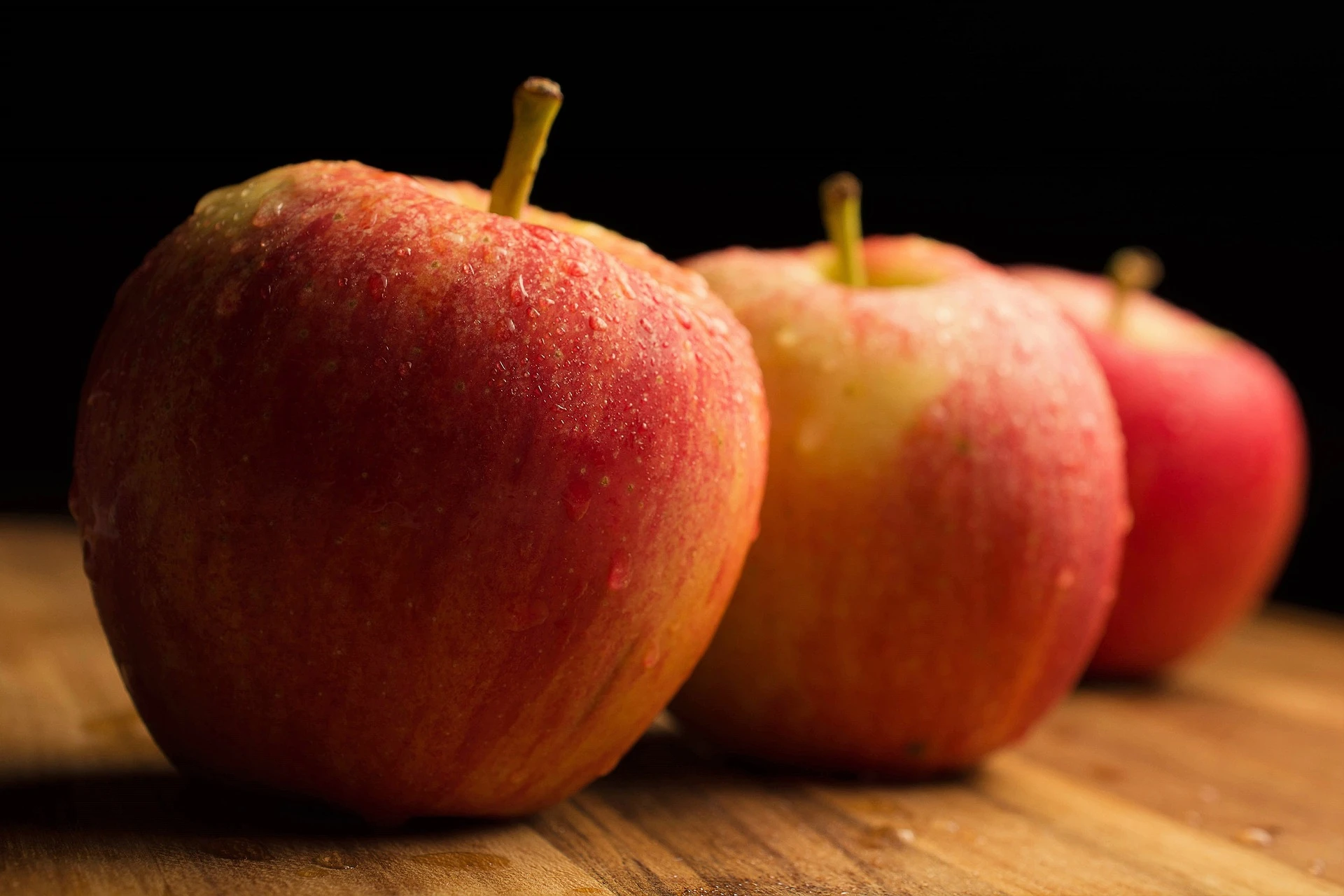 The Orne is the land of apple trees. Image chosen by monsieurdefrance.com 3938030 from Pixabay
The Orne is the land of apple trees. Image chosen by monsieurdefrance.com 3938030 from Pixabay
Normandy is, of course, the land of apple trees in blossom in spring and apples harvested in autumn. Cider is made from them. Norman cider is excellent. Personally, I prefer it because it's not too sweet. You can have it sweet, but brut is better. It's a great accompaniment to many dishes, and especially among the old folks, it's never far away, and they'll often offer you a "coup d'cit'" if you're passing by. In Le Theil sur Huisne, you can discover how cider is made with a visit to a cider house.
Cider and apples. Image chosen by monsieurdefrance.com: Belchonock via depositphotos.
The Orne is also home to Calva, a strong alcohol made from apples. Calvados has been around since the 16th century. The older the Calvados, the better it is, even in the bottle, although it's only really as good as the several years it spends in oak casks (the minimum is 2 years).
The perry
Pears, of which the Orne region is abundant. Image selected by monsieurdefrance.com by Alicja from Pixabay
A divine surprise, this beverage is, in a way, the cider of pears. Very fine, with small bubbles, it's the perfect accompaniment to an aperitif or dessert. It's the speciality of the eastern part of the department around Domfront (but also in the Houlme). The pear trees are plentiful, and their blossoming is just as spectacular as that of the apple trees. There's also the Poiré road.
Warning : alcohol abuse is dangerous for your health. Drink in moderation.
Camembert
Well done, with a glass of red wine. We love Camembert! Image chosen by monsieurdefrance.com: Shutterstock.
Camembert, in the Orne region of France, is the birthplace of this famous cheese, still the most popular in France. Here's a look at its history, along with some great recipes, notably for tarts and fondues (they're not light, but they're so good!). Orne is also a great land for butter and cream. We're not in Normandy for nothing!
Orne: how to get there Info / Geo / Web
Situation
L'Orne is about 200 kms from Paris via the A11 motorway. Le Mans is 30 minutes from Alençon. Caen is 45 minutes from Argentan.
Map of Orne. Screenshot from google maps.
Train
The département is located on the Paris / Granville rail route and on the Caen / Le Mans route.
Alençon station is located at: Place de la Résistance 61 000 ALENCON
Argentan station is located at: Place Pierre SEMARD 61 200 ARGENTAN
Plane
Bagnoles de l'Orne has its own airfield. The nearest airport is CAEN CARPIQUET. Paris airports are 2 hours 30 minutes away.
Websites
The Orne Tourisme website is very well designed and offers many ideas for outings and hikes.

